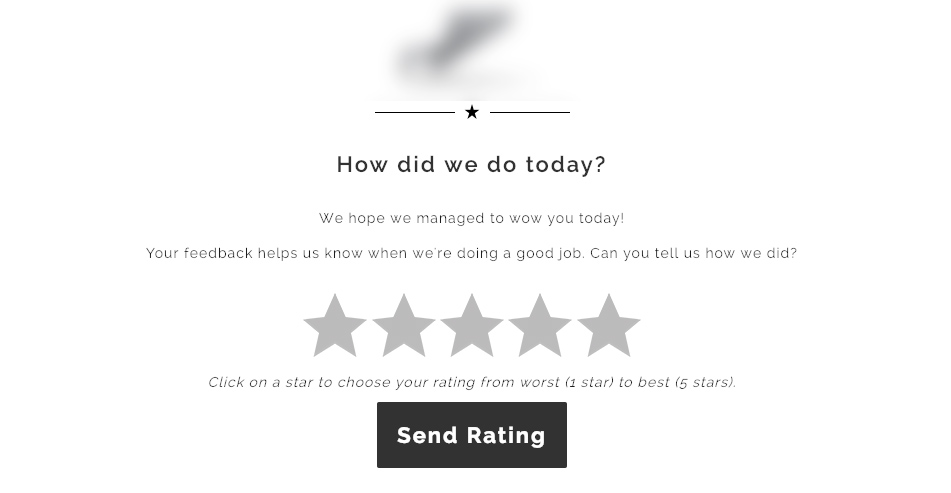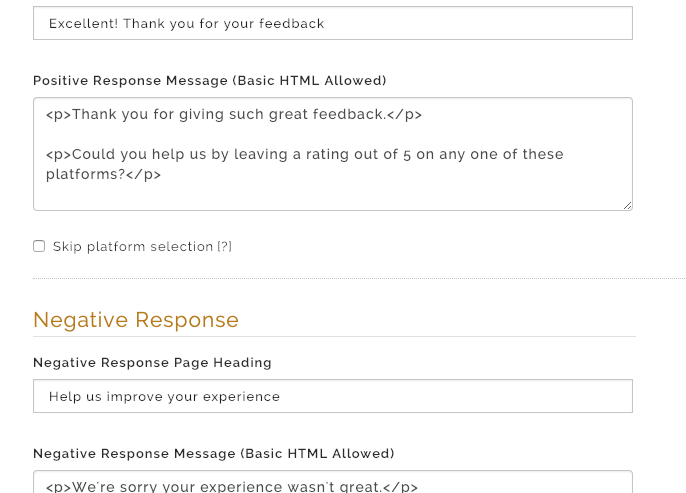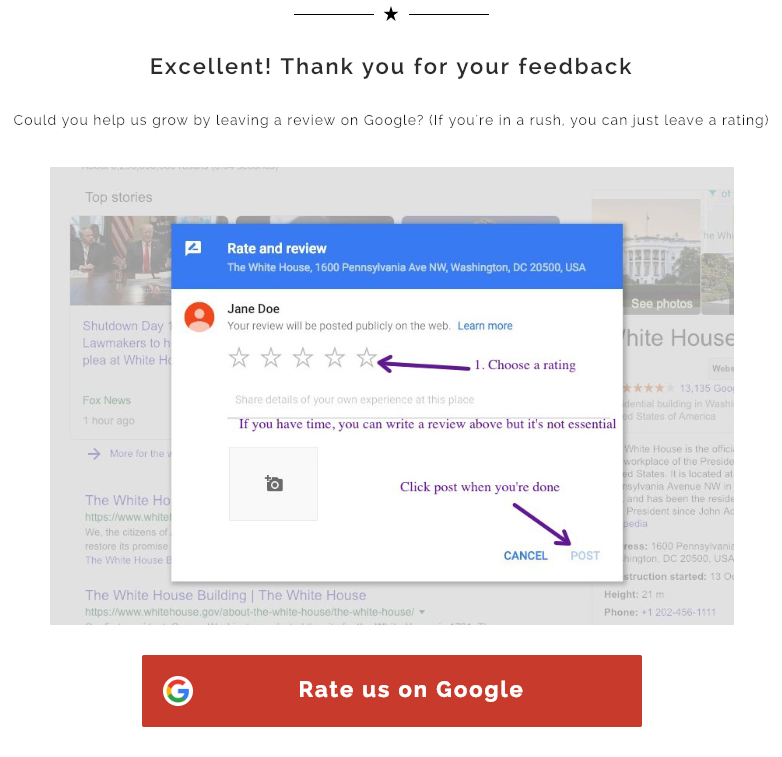This is a fairly technical and in-depth article about getting more reviews. It’s aimed at local businesses and the people who manage their local marketing, who are already receiving reviews and want to optimize the process.
If you’re looking for a general overview on getting started or techniques for generating reviews try this article instead – Getting more Online Reviews .
Just like any digital marketing campaign, review generation is based on a funnel with various stages. Whenever you see a relatively low number of reviews compared to the amount of feedback requests sent, it’s usually down to a problem at one or more parts of the funnel.

We encourage our users to look at each stage of the funnel, and then use this guide to fix potential issues that are getting in the way of receiving more reviews at the end of it.
Your current funnel – seeing the numbers
Before you start, take a look at your current numbers to get an idea of your conversion rates at the various stages of the funnel. At the various least, for requests sent by email or SMS, you should have an understanding of
– Your average open rate
– Your average click through rate
and where possible
– The percentage of people who left feedback and
– The percentage of people who went on to leave a review.
If you’re using Optimum Feedback head to your Feedback Campaign Report to see what your current conversion rates are. Go to Campaigns > Campaigns and click the graph icon next to the campaign name.

Stage A – SMS / Email Received
The Problem
You suspect a high percentage of email or SMS messages are not being received.
This is less of a problem for SMS messages and more of an email issue. As the ISPs tend not to provide information on which messages fail to make the inbox, we have to use open rates as an indication. The most common deliverability issue is your email ended up in spam or being rejected by the recipient’s mail server.
The Solution
Getting a higher deliverability rate generally means
i) Having fewer emails go to spam or get rejected and
ii)Having fewer emails end up in the ‘Promotions’ tab for Gmail users.
Here are a few practical solutions to help with this
- If you’re sending emails through 3rd party software, ensure you have DKIM and a Return Path set up for your domain. These are two DNS entries that you add to your domain, that give us permission to send emails from your domain, on your behalf. Without them, most of your emails will end up in spam. You can check your DKIM and Return Path settings on Optimum by heading to Admin > Settings > Email Settings.
- Consider using an email address that the user would have previously received emails from before (for example, your order confirmation email address). If it’s possible, use one where they would have replied or sent an email to.
- Split test different subject lines and messages in your emails. The same rules apply here as they do to email marketing campaigns. Run your subject lines through a subject tester (e.g. sendcheckit.com) to help find the best options.
- Keep it simple. Overly long or promotional emails are more likely to end up in spam. The goal here is to solicit feedback and all focus should be on achieving that goal.
Stage B – SMS / Email Opened
The Problem
You suspect a significant amount of messages are being delivered but not being opened.
As an industry average, an open rate of 25% for B2B emails is about the norm. Our open rates through the platform tend to be a little higher because of factors like our ESP / ISP reputation, and the nature of the emails being sent.
For our customers overall, the average open rate is around 35%.
When surveyed, the most common reasons people gave for not opening a feedback request email was lack of immediacy (leaving it until later … which usually results in it getting buried under other emails) and being unaware that it was something that required them to take action.
The Solution
You can achieve a better open rate by making adjustments to
i) Your subject line and
ii) The sender (‘From’) name on your email
- Using the same approach as above, test different subject lines to see what resonates with your target audience. A subject line that works well for you, may not work so well for another company so it’s always best to experiment.
- Try and include some reason for the recipient to read your message right away. The most effective subject line, by open rate that we’ve seen so far …
“Your AC Repair – can you help before Monday?”
(thanks to the campaign owner for allowing us to share it!) - Choose a sender name your recipient will recognize. This is usually a combination of your company name and the person they’re most likely to have spoken to in the business. For example ‘Jane– Rapid AC’
Stage C – Feedback Completed
The Problem
Messages are being received and opened but only a small percentage of feedback requests are being completed.
The percentage of people who complete your feedback request is naturally tied to the question or the link in the message being clicked. Click through rates across all of our users vary widely between 5 – 72% depending on the company, the sender and how long ago the service was provided.
Naturally, those companies with the highest percentage of completed surveys are often those who are with the customer when the request is sent and can often walk them through completing it in person.
When surveyed, the most common reason people gave for not completing the feedback step was lack of time. All of our surveys, regardless of whether they’re NPS, CSAT or star ratings, all take just one-click to complete. Therefore, it would seem the real issue was communication. Recipients assumed that there was much more time required of them to give feedback.
The Solution
You can often increase the number of people completing your feedback request by setting their expectations in the email or on the SMS landing page. Take these two (real) examples


A subtle change in the wording increased click through rates from 8% in the first example to 18% in the second. A 2x improvement from setting clearer expectations.
Stage D – Review Clickthrough & Stage E – Review Completion
The Problem
You receive an ample amount of feedback, but very few people are continuing to leave external reviews (e.g a review on Google or Facebook).
When surveyed, the most common reasons people gave for not leaving an external review was
i) Not enough time. They thought the company did a great job, and wanted to leave a full and detailed review to thank them. They intended to return when they were in a better situation to type a long review after putting some thought into it.
ii) They didn’t realize that something else was required after leaving the initial feedback (they thought of it as an optional step rather than something they had to do).
The Solution
There are a few ways to increase the conversion from feedback to review.
- Some of our clients increase their conversion rate by reducing the number of platforms a user has to choose from, from three to just one. Optimum users can modify the platforms that appear by heading to Campaigns > Feedback Pages > {{Choose your feedback page}} and unticking the ‘Automatically manage platform recommendations’ checkbox.

- Optimum users can also modify the feedback flow to remove the screen that lets the user choose where they would like to leave a review, and automatically send them straight to the review box on your preferred platform.
Head to Campaigns > Feedback Pages > {{Choose your feedback page}} and tick the ‘Skip platform selection’ checkbox. The user will be taken directly to leave a review, once they’ve answered your initial feedback question.

- You can also change the ‘Positive Response Message’ to make it clearer that you are expecting them to leave a review. The feedback pages with the highest conversion rates usually include an image (or better, an animated gif) showing the customer how to leave a review on their chosen platform. Remember that the things which you take for granted as a tech savvy marketer, will often be alien to people not used to using IT!

Request Volume
These suggestions should help you see an increase in your request to review conversion rates but remember – this is all about volume.
Typical request to review conversion rates tend to be between 2% and 14%, excluding those companies who walk their customer through the process in person.
This means you need to send at least 50 requests to see one review, assuming you have a conversion rate at the lower end of the scale.
If you do not have enough natural volume to see results in the short term, try setting up a one-off campaign to target past customers from a mailing list.

